077c871bf3b75e65e687aa3c581eaea4.ppt
- Количество слайдов: 143

ОРУЖЈА ЗА МАСОВНО УНИШТАВАЊЕ (ИЛИ УБИЈАЊЕ)- WEAPONS OF MASS DESTRUCTION “On the morning of July 16, 1945, at 5: 29: 45 a. m. , a group of scientists, army officials, and famous personalities - including British ambassador Lord Halifax and Harvard president Dr. James B. Conant witnessed the detonation of "Fat Man, " a thirteenpound plutonium bomb, which caused a blaze of light and heat more brilliant than the rising sun. The eighteen-kiloton explosion shattered windows 120 miles from Trinity and rumbled as far as 250 miles away. The intense heat of the blast melted the surrounding sand into a green, glassy, radioactive substance dubbed "Trinitite, " which litters the site to this day. ”


- - - 1. ПОЈАМ И ВРСТЕ ОРУЖЈА ЗА МАСОВНО УНИШТАВАЊЕ 2. НУКЛЕАРНО ОРУЖЈЕ 3. ХЕМИЈСКО И БИОЛОШКО ОРУЖЈЕ 4. ПРОЛИФЕРАЦИЈА ОРУЖЈА ЗА МАСОВНО УНИШТАВАЊЕ 5. ЛИТЕРАТУРА

1. ПОЈАМ И ВРСТЕ ОРУЖЈА ЗА МАСОВНО УНИШТАВАЊЕ

ДЕФИНИЦИЈА n n “ОРУЖЈА ЗА МАСОВНО УНИШТАВАЊЕ РАЗЛИКУЈУ СЕ ОД КОНВЕНЦИОНАЛНИХ ОРУЖЈА ПО ЕНОРМНОЈ ПОТЕНЦИЈАЛНОЈ СМРТНОСТИ КОЈУ ИЗАЗИВАЈУ И ПО НЕДОСТАТКУ ДИСКРИМИНАТИВНОСТИ ПРЕМА ОНИМА КОЈЕ ЋЕ УБИЈАТИ“ (ЏОШУА С. ГОЛДСТАЈН) ОРУЖЈА ЗА МАСОВНО УБИЈАЊЕ, НЕ ЗА МАСОВНО УНИШТАВАЊЕ (ЊУТ ГИНГРИЧ)

ЧЕМУ СЛУЖЕ? n n n СЛУЖЕ ДРУГАЧИЈИМ ЦИЉЕВИМА НЕГО КОНВЕНЦИОНАЛНА ОРУЖЈА СРЕДСТВО ОДВРАЋАЊА (DETERRENCE)ЗА ВЕЛИКЕ СИЛЕ СИМБОЛИЧКО СРЕДСТВО ИЗЈЕДНАЧАВАЊА У МОЋИ-ЗА МАЊЕ ЗЕМЉЕ ЧИНИЛАЦ БЕЗ КОЈИХ СЕ ДАНАС ПОЈАМ ВЕЛИКЕ СИЛЕ НЕ МОЖЕ НИ ЗАМИСЛИТИ СЛУЧАЈ ИЗРАЕЛ, ИНДИЈА, ПАКИСТАН, ИРАК, ЈУЖНА АФРИКА И СЕВЕРНА КОРЕЈА

ВРСТЕ ОРУЖЈА ЗА МАСОВНО УНИШТАВАЊЕ: n n n НУКЛЕАРНО ОРУЖЈЕ ХЕМИЈСКО ОРУЖЈЕ БИОЛОШКО ОРУЖЈЕ

2. НУКЛЕАРНА ОРУЖЈА “As the bomb fell over Hiroshima and exploded, we saw an entire city disappear. I wrote in my log the words : “My God, what have we done” – Capt. , Robert Lewis, U. S. Army Air Corps, copilot of the Enola Gay - - “A World without nuclear weapons would be lees stable and more dangerous for all of us”- former British prime minister Margaret Thatcher

n n n 2. 1. ПОЈАМ, ИСТОРИЈАТ И ВРСТЕ НУКЛЕАРНИХ ОРУЖЈА 2. 2. ФИСИОНА НУКЛЕАРНА ОРУЖЈА (АТОМСКА БОМБА) 2. 3. ФУЗИОНА НУКЛЕАРНА ОРУЖЈА 2. 4. НАЧИНИ ИСПАЉИВАЊА И ПРЕНОШЕЊА (DELIVERY) 2. 5. НУКЛЕАРНЕ СТРАТЕГИЈЕ 2. 6. ДЕКЛАРИСАНЕ И НЕДЕКЛАРИСАНЕ НУКЛЕАРНЕ СИЛЕ ДАНАС

2. 1. ИСТОРИЈАТ, ПОЈАМ И ВРСТЕ НУКЛЕАРНИХ ОРУЖЈА:

ИСТОРИЈАТ: n - - ДРУГИ СВЕТСКИ РАТ И ПРОЈЕКАТ “МЕНХЕТН“ РОБЕРТ ОПЕНХАЈМЕР, МАРТИН БОР, АЛБЕРТ АЈНШТАЈН. . . НЕМАЧКИ ПРОЈЕКТИ СОВЈЕТСКИ ПОТЕЗИ ТРУМАН И АТОМСКА БОМБА 16. ЈУЛ 1945. ГОДИНЕ- НОВИ МЕКСИКО ТРУМАН И СТАЉИН У ПОТСДАМУ: “ШАПТАЊЕ НА УХО“ СТАЉИНОВА ПАРАНОЈА И ОБАВЕШТАЈНИ ПОДАЦИ 6. и 9. АВГУСТ 1945. - ХИРОШИМА И НАГАСАКИ (" LITTLE BOY“ И “FAT MAN“) КОМИСИЈА ЗА КОНТРОЛУ НУКЛЕАРНОГ НАОРУЖАЊА И БАРУХОВ ПЛАН“ МИТ О АМЕРИЧКОЈ НУКЛЕАРНОЈ ХЕГЕМОНИЈИ ПОСЛЕ ДРУГОГ СВЕТСКОГ РАТА И СОВЈЕТСКИ ПУТ КА БОМБИ (2 бомбе 1947. и 50 1948. ) Б-36

ДЕФИНИЦИЈА: n n НУКЛЕАРНА ОРУЖЈА КАО ОРУЖЈА КОЈА КАО УБОЈНО СРЕДСТВО КОРИСТЕ НУКЛЕАРНУ ЕНЕРГИЈУ НАЈРАЗОРНИЈА ОРУЖЈА КОЈА СУ НА РАСПОЛАГАЊУ ДРЖАВАМА БОМБА ВЕЛИЧИНЕ ФРИЖИДЕРА МОЖЕ ДА УНИШТИ ЧИТАВ ЈЕДАН ГРАД + ФАКТОР РАДИЈАЦИЈА ОДБРАНА ПРОТИВ ЊИХ ЈЕ ВЕОМА ТЕШКА

Robert Oppenheimer and Lesley Grows




“Little boy” and Hiroshima


“Bockscar” and “Fat Man”



ВРСТЕ НУКЛЕАРНИХ ОРУЖЈА: n n ФИСИОНА НУКЛЕАРНА ОРУЖЈА (АТОМСКЕ ИЛИ А-БОМБЕ) ФУЗИОНА НУКЛЕАРНА ОРУЖЈА (ТЕРМОНУКЛЕАРНЕ БОМБЕ, ХИДРОГЕНСКЕ БОМБЕ ИЛИ ХБОМБЕ)

ФИСИОНА НУКЛЕАРНА ОРУЖЈА (АТОМСКЕ ИЛИ А-БОМБЕ) n n n ЈЕДНОСТАВНИЈЕ И ЈЕФТИНИЈЕ ЗА ПРОИЗВОДЊУ РАДЕ НА ПРИНЦИПУ ФИСИЈЕ (ЦЕПАЊА) АТОМА ПРИЛИКОМ ЧЕГА СЕ ИЗГУБЉЕНА МАСА ТРАНСФОРМИШЕ У ЕНЕРГИЈУ ПРЕМА АЈНШТАЈНОВОЈ ФОРМУЛИ Е=Mx(Cx. C)-мала маса, велика енергија Постоје два хемијска елемента која се користе у те сврхе: уранијум-235 (У 235) и плутонијум

КАКО “РАДЕ“ НУКЛЕАРНА ОРУЖЈА? n ДА БИ СЕ ДОБИЛА КРИТИЧНА МАСА КОЈА ЋЕ ЕКСПЛОДИРАТИ ЈЕДНО ПАРЧЕ УРАНИЈУМА СЕ У НЕКОЈ УСКОЈ ЦЕВИ "БОМБАРДУЈЕ“ КОНВЕНЦИОНАЛНИМ ЕКСПЛОЗИВОМ И ПРЕНОСИ ПРЕКО ТЕ ЦЕВИ ДО ДРУГОГ КОМАДА УРАНИЈУМА

ФИСИОНИ ЕЛЕМЕНТИ n n УРАНИЈУМ ПЛУТОНИЈУМ

ПРЕПРЕКЕ ЗА ЊИХОВО ДОБИЈАЊЕ: n n УРАНИЈУМ: Пет или мање килограма довољно за једну атомску бомбу У-235 се веома тешко добија, јер природни уранијум садржи мање од 1% У-235 Екстраховање У-235 из природног уранијума је скуп, спор и технички вепма захтеван процес

n n Uranium occurs naturally in underground deposits consisting of a mixture of 0. 7% uranium-235, which is easily fissionable, and about 99. 3% uranium-238, which is not fissionable. Nuclear weapons require "enrichment" to increase the proportion of U 235 to 90% or more. This is called Highly Enriched Uranium (HEU). Nuclear reactors require enrichment to about 3 - 5 % of U-235. This is called Low Enriched Uranium (LEU). HEU can be combined with plutonium to form the "pit", or core of a nuclear weapon, or it can be used alone as the nuclear explosive. The bomb dropped on Hiroshima used only HEU. About 1520 kgs of HEU are sufficient to make a bomb without plutonium.

ПРЕПРЕКЕ ЗА ЊИХОВО ДОБИЈАЊЕ: n n n ПЛУТОНИЈУМ: ПЛУТОНУЈУМ ЈЕ НАЈЛАКШЕ ДОБИТИ ИЗ УРАНИЈУМА КОЈИ СЕ КОРИСТИ У НУКЛЕАРНИМ РЕАКТОРИМА ТЕХНИЧКИ ТЕЖЕ НАПРАВИТИ БОМБУ ОД ЊЕГА КОРИСТИ СЕ И У КОМЕРЦИЈАЛНИМ НУКЛЕАРНИМ РЕАКТОРИМА БОМБЕ БАЧЕНЕ НА ХИРОШИМУ И НАГАСАКИ БИЛЕ СУ ЈЕДНА УРАНИЈУМСКА А ЈЕДНА ПЛУТОНИЈУМСКА АТОМСКЕ БОМБЕ СУ ГЛАВНА ОПАСНОСТ ДАНАС И КАД СЕ ГОВОРИ О ПРОЛИФЕРАЦИЈИ НУКЛЕРАНОГ ОРУЖЈА ПРВЕНСТЕВЕНО СЕ МИСЛИ НА ФИСИОНА НУКЛЕАРНА ОРУЖЈА

n n n Plutonium is not found naturally in significant quantities. It is produced in a nuclear reactor through the absorption of neutrons by Uranium 238. The Plutonium emerges from a nuclear reactor as part of the mix in spent nuclear fuel, along with unused uranium and other highly radioactive fission products. To get plutonium into a usable form, a second key facility, a reprocessing plant, is needed to chemically separate out the plutonium from the other materials in spent fuel. Once plutonium is separated, it can be processed and fashioned into the fission core of a nuclear weapon, called a "pit". Nuclear weapons typically require three to five kilograms of plutonium. Plutonium can also be converted into an oxide and mixed with uranium dioxide to form mixedoxide (MOX) fuel for nuclear reactors. Britain, France, Russia, India, Japan, Israel and China operate reprocessing plants to obtain plutonium (the last two only for military purposes). U. S. plutonium production reactors were shut down in 1988. A number of isotopes of plutonium are produced in a reactor, the most common being Pu-239 which is easily fissionable, and Pu-240 which is not. The relative proportion of Pu-239 determines the weapons grade of the plutonium. Reactor grade Pu, i. e. Pu with 18% or more Pu-240, can still be used to make a "crude" nuclear bomb.

n n n ФУЗИОНА НУКЛЕАРНА ОРУЖЈА (ТЕРМОНУКЛЕАРНЕ БОМБЕ, ХИДРОГЕНСКЕ ИЛИ Х-БОМБЕ) ЊИХОВА ИЗРАДА ЈЕ ВЕОМА, ВЕОМА СКУПА И ТЕХНОЛОШКИ ВЕОМА ЗАХТЕВНА ОВА ОРУЖЈА РЕЗЕРВИСАНА СУ ЗА НАЈВЕЋЕ, НАЈБОГАТИЈЕ И ТЕХНОЛОШКИ НАЈНАПРЕДНИЈЕ ДРЖАВЕ МАЊЕ ВАЖНА У ПОСЛЕХЛАДНОРАТОВСКОМ СВЕТУ

n November 1, 1952, The United States detonates the first hydrogen bomb, 10. 4 megaton Mike , at Enewetak Atoll in the Marshall Islands. The explosion is 500 times more powerful than the bomb exploded at Nagasaki.

The "Mike" shot in 1952 inaugurated the age of fusion weapons.


The H- Bomb


МНОГО ВЕЋЕ РАЗОРНЕ МОЋИ НЕГО АТОМСКЕ БОМБЕ n n n ЕКСПЛОЗИВНА МОЋ НАЈВЕЋЕГ ДЕЛА ФИСИОНИХ ОРУЖЈА КРЕЋЕ СЕ ИЗМЕЂУ 1 И 200 КИЛОТОНА (1 КТ ЈЕДНАКО ЈЕ ИЗНОСУ ОД 1000 ТОНА КОНВЕНЦИОНАЛНОГ ЕКСПЛОЗИВА) ЕКСПЛОЗИВНА МОЋ ФУЗИОНИХ НУКЛЕРАНИХ ОРУЖЈА КРЕЋЕ СЕ ОД 1 -20 МЕГАТОНА (1 МТ ЈЕДНАКО ЈЕ ИЗНОСУ ОД 1000 КИЛОТОНА) НАЈВЕЋА НУКЛЕАРНА ЕКСПЛОЗИЈА ИКАДА ИЗВРШЕНА НА ТЕРИТОРИЈИ ЗЕМЉЕ ДЕСИЛА СЕ 1961. ГОДИНЕ КАДА СУ СОВЈЕТИ ПРОБАЛИ ХИДРОГЕНСКУ БОМБУ ОД 60 МЕГАТОНА, ЧИЈА ЈЕ РАЗОРНА МОЋ БИЛА ТРИ ПУТА ВЕЋА НЕГО СВА ЕКСПЛОЗИВНА СРЕДСТВА КОРИШЋЕНА У ДРУГОМ СВЕТСКОМ РАТУ

КАКО “РАДЕ“ ФУЗИОНА НУКЛЕАРНА ОРУЖЈА? n n n КОД ОВИХ ОРУЖЈА ДВА МАЛА АТОМА (ВАРИЈАНТЕ ХИДРОГЕНА) СПАЈАЈУ СЕ (ВРШИ СЕ ФУЗИЈА) У ЈЕДАН ВЕЋИ АТОМ, ПРИ ЧЕМУ СЕ ОСЛОБАЂА НУКЛЕАРНА ЕНЕРГИЈА СВЕ ОВО СЕ ОДИГРАВА НА ВЕОМА ВИСОКИМ ТЕМПЕРАТУРАМА А ДА БИ СЕ ОНЕ СТВОРИЛЕ КОРИСТЕ СЕ ФИСИОНА ОРУЖЈА

The Neutron Bomb n n n The tactical neutron bomb is a nuclear weapon that maximizes damage to people but minimizes damage to buildings and equipment. It is also called an enhanced radiation warhead. The neutron bomb is a specialized thermonuclear weapon that produces a minimal blast but releases large amounts of lethal radiation which can penetrate armor or several feet of earth. 1962 -The first neutron device is successfully tested. . U. S. production of the bomb was postponed in 1978 and resumed in 1981. "



КАКО “УНИШТАВАЈУ“ НУКЛЕАРНА ОРУЖЈА? n n n n n ВЕЛИКА ЕКСПЛОЗИВНА МОЋ ТОПЛОТА-ЕСПЛОЗИЈА ХИДРОГЕНСКЕ БОМБЕ КАПАЦИТЕТА 1 МТ СТВАРА ТЕМПЕРАТУРУ ОД 100 МИЛИОНА ЦЕЛСЗИЈУСА РАДИЈАЦИЈА ПРОТИВРЕЧНОСТИ? ХИРОШИМА И НАГАСАКИ? А ДАЉЕ? ДО САДА ЈЕ БИЛО НЕШТО ВИШЕ ОД 2000 НУКЛЕАРНИХ ПРОБА КРУГОВИ ЗРАЧЕЊА ЕЛЕКТРОМАГНЕТНИ ПУЛС НУКЛЕАРНА ЗИМА

n n Blast Thermal radiation Initial nuclear radiation Fallout


Blast n n The rapid release of energy in an explosion creates a shock wave of overpressure. Very close to the centre of a nuclear explosion, overpressure is equivalent to several thousand pounds per square inch (psi). This is hundreds of times greater than the pressure in a pressure cooker. The overpressure crushes objects. Human lungs are crushed at about 30 psi overpressure. Brick houses are destroyed at about 10 -15 psi overpressure. The blast also generates high velocity winds which can turn humans or objects into missiles. At 15 - 20 psi the winds can fling a person at several hundred kilometres per hour

The effects of the blast wave on a typical wood framed house.

Blast effects on a concrete building at Hiroshima.

Thermal radiation n n Thermal radiation includes light and heat. Nuclear weapons release a huge amount of energy as light (ultraviolet, visible and infrared). This light is so intense that it can make sand explode, blind people many miles away, burn shadows into concrete, burn skin and ignite flammable materials at large distances. The heat at the centre of the explosion (epicentre) is so intense as to vapourise most materials. The thermal radiation creates a fireball which expands rapidly outwards consuming oxygen and, combined with the blast effect, creating near total destruction for some distance from the epicentre.

n n n Temperatures of a nuclear explosion reach those in the interior of the sun, about 100, 000° Celsius, and produce a brilliant fireball. The fireball, an extremely hot and highly luminous spherical mass of air and gaseous weapon residues, occurs within less than one millionth of one second of the weapon's detonation. Immediately after its formation, the fireball begins to grow in size, engulfing the surrounding air. It has then risen roughly 4. 5 miles from the point of burst.

Illustrated components of a nuclear explosion.

The mushroom cloud forming at the Nevada Test Site.

n One of the important differences between a nuclear and conventional weapon is the large proportion of a nuclear explosion's energy that is released in the form of thermal energy. This energy is emitted from the fireball in two pulses. The first is quite short, and carries only about 1 percent of the energy; the second pulse is more significant and is of longer duration (up to 20 seconds).

The thermal pulse charring the paint


n n n n Under some conditions, the many individual fires created by a nuclear explosion can coalesce into one massive fire known as a "firestorm. “ For a firestorm to develop: There must be at least 8 pounds of combustibles per square foot. At least one-half of the structures in the area are on fire simultaneously. There is initially a wind of less than 8 miles per hour. The burning area is at least 0. 5 square miles. In Hiroshima, a firestorm did develop and about 4. 4 square miles were destroyed. Although there was some damage from uncontrolled fires at Nagasaki, a firestorm did not develop. One reason for this was the difference in the terrain. Hiroshima is relatively flat, while Nagasaki has uneven terrain.

The firestorm at Hiroshima

n n Flash Burns Flash burns are one of the serious consequences of a nuclear explosion. Flash burns result from the absorption of radiant energy by the skin of exposed individuals. A distinctive feature of flash burns is the fact they are limited to exposed areas of the skin facing the explosion.

n n A 1 -megaton explosion cause first-degree burns (a bad sunburn) at a distance of about 7 miles, second-degree burns (producing blisters and permanent scars) at distances of about 6 miles, and third-degree burns (which destroy skin tissue) at distances up to 5 miles. Third-degree burns over 24 percent of the body, or seconddegree burns over 30 percent, will result in serious shock, and will probably prove fatal unless prompt, specialized medical care is available. It has been estimated that burns caused some 50 percent of the deaths at Hiroshima and Nagasaki.

The burns are in a pattern corresponding to the dark portions of the kimono she was wearing at the time of the explosion.

n n Flash blindness is caused by the initial brilliant flash of light produced by the nuclear detonation. The light is received on the retina than can be tolerated, but less than is required for irreversible injury. The retina is particularly susceptible to visible and short wavelength infrared light. The result is a bleaching of visual pigment and temporary blindness. Vision is completely recovered as the pigment is regenerated. During the daylight hours, flash blindness does not persist for more than 2 minutes, but generally lasts a few seconds. At night, when the pupil is dilated, flashblindness will last for a longer period of time. A 1 -megaton explosion cause flash blindness at distances as great as 13 miles on a clear day, or 53 miles on a clear night. If the intensity is great enough, a permanent retinal burn will result.

Initial nuclear radiation n Initial radiation consists mostly of gamma rays and neutrons which are generated in the nuclear reaction and can enter the human body directly. In general a radiation dose of 400 rads will be lethal to 50% or more of the exposed population. These deaths occur within about 6 - 7 weeks.

Fallout n n Fallout consists of large numbers of particles, from the earth, buildings and other ground objects, which are irradiated by the explosion, mixing with the radioactive products of the explosion itself and then being distributed over a wide area by wind. An example of a fallout pattern is given in the table. There a large number of radioactive products from a nuclear explosion. These lodge in different parts of the body (table [ ]). The radioactive products emit different types of radiation - alpha particles, beta particles or gamma rays, which differ in the degree of damage they can do. Alpha particles do the most damage once inside the body, but do little damage outside as they cannot penetrate skin. There is no known way of nuetralising a radioactive substance, apart from sending it through a nuclear reactor. Thus, radioactive products are dangerous until they have decayed to such an extent that they no longer emit significant amounts of radiation. This time is usually considered to be 10 times the half-life. The effects of fallout persist for hundreds of years, although the relative risk reduces over time.

Electromagnetic Pulse n Electromagnetic pulse (EMP) is an electromagnetic wave similar to radio waves, which results from secondary reactions occurring when the nuclear gamma radiation is absorbed in the air or ground. It differs from the usual radio waves in two important ways. First, it creates much higher electric field strengths. Whereas a radio signal might produce a thousandth of a volt or less in a receiving antenna, an EMP pulse might produce thousands of volts. Secondly, it is a single pulse of energy that disappears completely in a small fraction of a second. In this sense, it is rather similar to the electrical signal from lightning, but the rise in voltage is typically a hundred times faster. This means that most equipment designed to protect electrical facilities from lightning works too slowly to be effective against EMP.

The range of the EMP effects of a high altitude burst

Ozone Depletion n When a nuclear weapon explodes in the air, the surrounding air is subjected to great heat, followed by relatively rapid cooling. These conditions are ideal for the production of tremendous amounts of nitric oxides. These oxides are carried into the upper atmosphere, where they reduce the concentration of protective ozone. Ozone is necessary to block harmful ultraviolet radiation from reaching the Earth's surface.

Nuclear Winter n n In 1983, R. P. Turco, O. B. Toon, T. P. Ackerman, J. B. Pollack, and Carl Sagan (referred to as TTAPS) published a paper entitled "Global Atmospheric Consequences of Nuclear War" which is the foundation on which the nuclear winter theory is based on. Theory states that nuclear explosions will set off firestorms over many cities and forests within range. Great plumes of smoke, soot, and dust would be sent aloft from these fires, lifted by their own heating to high altitudes where they could drift for weeks before dropping back or being washed out of the atmosphere onto the ground. Several hundred million tons of this smoke and soot would be shepherded by strong west-to-east winds until they would form a uniform belt of particles encircling the Northern Hemisphere.

n It is not certain that a nuclear would produce a nuclear winter effect. However, it remains a possibility and the TTAPS study concluded: ". . . the possibility of the extinction of Homo Sapiens cannot be excluded. "

n These thick black clouds could block out all but a fraction of the sun's light for a period as long as several weeks. The conditions of semidarkness, killing frosts, and subfreezing temperatures, combined with high doses of radiation from nuclear fallout, would interrupt plant photosynthesis and could thus destroy much of the Earth's vegetation and animal life. The extreme cold, high radiation levels, and the widespread destruction of industrial, medical, and transportation infrastructures along with food supplies and crops would trigger a massive death toll from starvation, exposure, and disease.

Противречности? Досада бачено само две атомске бомбе - Претпоставке и пројекције? -

n “There were 18 Japanese who survived the atomic attack on Hiroshima, were among those who fled to Nagasaki and then also survived the atomic attack on that city three days later”

2. 4. НАЧИНИ ИСПАЉИВАЊА И ПРЕНОСА (DELIVERY) НУКЛЕАРНОГ ОРУЖЈА

НУКЛЕАРНА ОРУЖЈА СЕ МОГУ "ДОВЕСТИ" ДО ЊИХОВИХ МЕТА НА ЈЕДАН ОД СЛЕДЕЋИХ НАЧИНА:

n n n АВИОНИ- ОД Б-29, ПРЕКО Б-36 ДО СТРАТЕШКИХ НУКЛЕАРНИХ БОМБАРДЕРА РАЗЛИЧИТЕ ВРСТЕ КОНВЕНЦИОНАЛНИХ ЕКСПЛОЗИВНИХ НАПРАВА ТИПА ЗЕМЉАВАЗДУХ и СОФИСТИФИКОВАНИХ МОБИЛНИХ СИСТЕМА SUBMARINE LAUNCHED MISSILES (SLBMs) БАЛИСТИЧКЕ РАКЕТЕ (BALLISTIC MISSILES) КРСТАРЕЋЕ РАКЕТЕ

Стратегијски бомбардери

B – 29 “Superfortress”

B – 36 "Peacemaker"

n The Convair B-36 was a strategic bomber built by Convair for the United States Air Force, the first to have truly intercontinental range. Unofficially nicknamed the "Peacemaker", the B-36 was the first thermonuclear weapon delivery vehicle, the largest piston aircraft ever to be mass-produced, and the largest warplane of any kind. Although there have been larger military aircraft, they have all been transports.

B – 52

n n Air Combat Command's B-52 is a long-range, heavy bomber that can perform a variety of missions. The bomber is capable of flying at high subsonic speeds at altitudes up to 50, 000 feet (15, 166. 6 meters). It can carry nuclear or precision guided conventional ordnance with worldwide precision navigation capability. The use of aerial refueling gives the B-52 a range limited only by crew endurance. It has an unrefueled combat range in excess of 8, 800 miles (14, 080 kilometers)

SUBMARINE LAUNCHED MISSILES


Trident II

Tomahawk

БАЛИСТИЧКЕ РАКЕТЕ n n ГЛАВНИ “ИСПОРУЧИЛАЦ“ НУКЛЕАРНОГ ОРУЖЈА ОНЕ НОСЕ НУКЛЕАРНЕ БОЈЕВЕ ГЛАВЕ ДУЖ ТРАЈЕКТОРИЈА И СПУШТАЈУ ИХ НА МЕТУ ЛЕТЕ 50 000 МИЉА ИЗНАД АТМОСФЕРЕ, ШТО ИХ ЧИНИ ПРАКТИЧНО “НЕОБОРИВИМ“ СИСТЕМ НАВОЂЕЊА

Peenemünde Museum replica of the first successful V-2 rocket. n The Vergeltungswaffe 2 ("Reprisal weapon 2") (V 2), also known as the A 4 (Aggregat 4), was an early ballistic missile used by the German Army primarily against Belgian and British targets during the later stages of World War II. The V-2 was the first manmade object launched into space, during test flights that reached an altitude of 189 km (117 miles). It was the progenitor of the space race, which ultimately put men on the moon, and resulted in probes that have now left our solar system.

ВРСТЕ БАЛИСТИЧКИХ РАКЕТА: n n n ТАКТИЧКЕ: ДОМЕТ ОД 500 ДО 1000 МИЉА (SHORTRANGE BALLISTIC MISSILES)-ГЛАВНА ОПАСНОСТ У ПОСЛЕХЛАДНОРАТОВСКОМ СВЕТУ РАКЕТЕ СРЕДЊЕГ ДОМЕТА: ОД 1000 ДО 5000 МИЉА (INTERMEDIATE BALLISTIC MISSILES) СТРАТЕГИЈСКЕ: ДОМЕТА ПРЕКО 5000 МИЉА-РАСТОЈАЊЕ ОД ЧИКАГА ДО МОСКВЕ (INTERCONTINENTAL BALISTIC MISSILES- ICBMs)

The United States divides missiles into four range classes n n Intercontinental Ballistic Missile ICBM over 5500 kilometers Intermediate-Range Ballistic Missile IRBM 3000 to 5500 kilometers Medium-Range Ballistic Missile MRBM 1000 to 3000 kilometers Short-Range Ballistic missile SRBM up to 1000 kilometers

The Soviet and Russian military developed a system of five range classes n n n Strategic over 1000 kilometers Operational-Strategic 500 to 1000 kilometers Operational 300 to 500 kilometers Operational-Tactical 50 to 300 kilometers Tactical up to 50 kilometers

Intercontinental Ballistic Missile ICBM

n n Intercontinental Ballistic Missiles (ICBMs) have ranges of greater than 5, 500 km. ICBMs create a problem because they enable a country to break out of a regional context and move toward potential global impact. Regardless of the origin of a conflict, a country may involve the entire world simply by threatening to spread the war with an ICBM.

SM-68 B Titan II




Topolj-m



БАЛИСТИЧКЕ РАКЕТЕ: "ИМОВИНСКА КАРТА" n n n n n n САД, РУСИЈА И КИНА: 13 000 (ДОМЕТ: СВЕТ) БРИТАНИЈА-4600, ФРАНЦУСКА- 3700 (SBLMs, ДОМЕТ: СВЕТ) (SBLMs, СЕВЕРНА КОРЕЈА 800 -3000 (ДОМЕТ: ЈУЖНА КОРЕЈА, РУСИЈА, КИНА, ЈАПАН) ИНДИЈА 150 -1500 (ДОМЕТ: ПАКИСТАН, КИНА, АВГАНИСТАН, ИРАН, ТУРСКА, ИНДИЈА) ПАКИСТАН 175 -400 (ДОМЕТ: ИНДИЈА) ИРАН 300 -1250 (ДОМЕТ: ИРАК, КУВАЈТ, АВГАНИСТАН, ИЗРАЕЛ, ЕГИПАТ, ТУРСКА, САУДИ АРАБИЈА, РУСИЈА, ИНДИЈА) САУДИ АРАБИЈА ИЗРАЕЛ ИРАК СИРИЈА ЕГИПАТ ЈЕМЕН УЈЕДИЊЕНИ АРАПСКИ ЕМИРАТИ АВГАНИСТАН ЈУЖНА КОРЕЈА ВИЈЕТНАМ БЕЛОРУСИЈА УКРАЈИНА БУГАРСКА СЛОВАЧКА ЧЕШКА ПОЉСКА РУМУНИЈА ЈАПАН?

2. 5. НУКЛЕАРНЕ СТРАТЕГИЈЕ

ПОЈАМ НУККЛЕАРНИХ СТРАТЕГИЈА n НУКЛЕАРНЕ СТРАТЕГИЈЕ СУ НАЧИНИ НА КОЈИ ЋЕ ДРЖАВЕ ОДЛУЧИТИ КОЛИКО ЋЕ РАЗВИТИНУКЛЕАРНИХ ПРЈЕКТИЛА, КАКО ЋЕ ИХ “ИСПОРУЧИТИ“ ДО МЕА, И КАКО ЋЕ ИХ УПОТРЕБЉАВАТИ У ЗАВИСНОСТИ ОД ОКОЛНОСТИ

СТРАТЕГИЈА МАСОВНЕ ОДМАЗДЕ n n n ЏОН ФОСТЕР ДАЛС ДВАЈТ АЈЗЕНХАУЕР ПРОБЛЕМАТИКА

СТРАТЕГИЈА ЕЛАСТИЧНОГ ОДГОВОРА n n n ХЕНРИ КИСИНЏЕР ЏОН КЕНЕДИ ПРОБЛЕМАТИКА

МАД (MUTUAL ASSURED DESTRUCTION) n n n ИГРА НА РАЦИОНАЛНОСТ ДОНОСИЛАЦА ПОЛИТИЧКИХ ОДЛУКА КАПАЦИТЕТИ ЗА ПРВИ НАПАД КАПАЦИТЕТИ ЗА ДРУГИ НАПАД

n The End of MAD? The Nuclear Dimension of U. S. Primacy; Keir A. Lieber and Daryl G. Press The age of MAD, however, is waning. Today the United States stands on the verge of attaining nuclear primacy vis-à-vis its plausible great power adversaries. For the first time in decades, it could conceivably disarm the long-range nuclear arsenals of Russia or China with a nuclear first strike. A preemptive strike on an alerted Russian arsenal would still likely fail, but a surprise attack at peacetime alert levels would have a reasonable chance of success. Furthermore, the Chinese nuclear force is so vulnerable that it could be destroyed even if it were alerted during a crisis. To the extent that great power peace stems from the pacifying effects of nuclear weapons, it currently rests on a shaky foundation.

n n n We use the term “nuclear primacy” to describe the situation in which the one country with primacy can destroy its adversary’s nuclear retaliatory capabilities in a disarming strike. In the last fifteen years, however, the strategic nuclear balance has shifted profoundly. Part of the shift is attributable to the decline of the Russian arsenal. Compared with the Soviet force in 1990, Russia has 58 percent fewer intercontinental ballistic missiles (ICBMs), 39 percent fewer bombers, and 80 percent fewer ballistic missile submarines (SSBNs). 16 Furthermore, serious maintenance and readiness problems plague Russia’s nuclear forces. China has only 18 single-warhead missiles that can reach the U. S. homeland If the United States can destroy all of Russia’s long-range nuclear systems in a first strike—as we argue it could possibly do today—it suggests that the Chinese strategic nuclear arsenal is far more vulnerable.
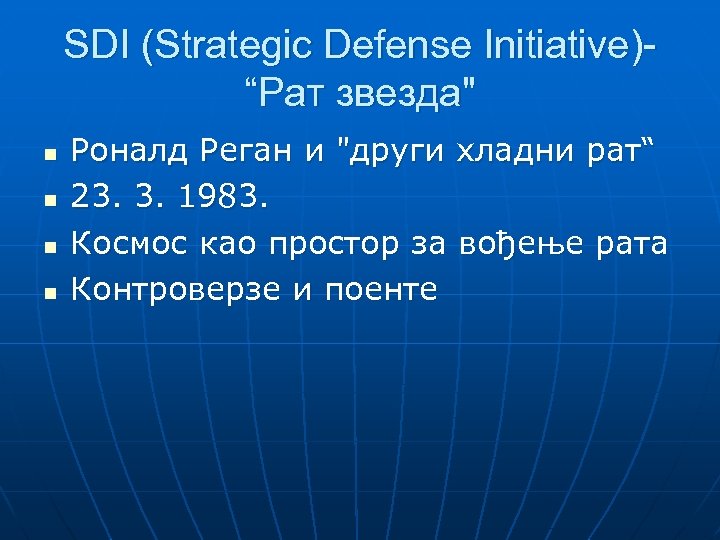
SDI (Strategic Defense Initiative)“Рат звезда" n n Роналд Реган и "други хладни рат“ 23. 3. 1983. Космос као простор за вођење рата Контроверзе и поенте


2. 6. КОНТРОЛА НУКЛЕАРНОГ НАОРУЖАЊА

БИЛАТЕРАЛНИ СПОРАЗУМИ: САД-СССР (РУСИЈА) n n n SALT I – 1972. SALT II – 1979. INF TREATY – 1987. START I – 1991. START II – 1993. STRATEGIC OFFENSIVE REDUCTION TREATY – 2002. (RIM)

SALT ( STRATEGIC ARMS LIMITATION TREATY) I- 1972. n n ABM TREATY (ANTIBALLISTIC MISSILE TREATY-БРАНЕ СЕ САМО ГЛАВНИ ГРАДОВИ, МОСКВА И ВАШИНГТОН) ПЕТОГОДИШЊЕ "ЗАМРЗАВАЊЕ“ НА РАЗВОЈ НОВИХ ICBMs и SLBMs

SALT II – 1979. n n n НИКАДА РАТИФИКОВАН-СОВЈЕТСКА ИНТЕРВЕНЦИЈА У АВГАНИСТАНУ ОГРАНИЧАВАЊЕ БАЛИСТИЧКИХ РАКЕТА ДУГОГ ДОМЕТА, ДО БРОЈКЕ ОД 2400. SLBMs СТРАТЕШКИ БОМБАРДЕРИ SURFACE TO AIR MISSILE LAUNCHERS

INF (INTERMEDIATE RANGE NUCLEAR FORCES) TREATY – 1987. n n n ДЕМОНТИРАЊЕ СВИХ СОВЈЕТСКИХ И АМЕРИЧКИХ РАКЕТА СРЕДЊЕГ ДОМЕТА ГЛАВНИ ПРОБЛЕМ “ДРУГОГ ХЛАДНОГ РАТА“ СС-20; ПЕРШИНГ

START I (STRATEGIC ARMS REDUCTION TREATY) – 1991. n n n ДА СЕ НУКЛЕАРНИ АРСЕНАЛ СМАЊИ 15% И РУСКИ ЗА 25%; САД СА 12 081 НА 10 395; СССР СА 10 841 НА 8 040

START II – 1993. n n ЗА 50% СМАЊЕЊЕ НУКЛЕАРНОГ АРСЕНАЛА ПУТИН ГА РАТИФИКОВАО 2000. ГОДИНЕ

STRATEGIC OFFENSIVE REDUCTION TREATY-2002. n n СА 6 000 НА 2 200 ДО КРАЈА ДЕЦЕНИЈЕ ЕЛИМИНИСАТИ СВА ТАКТИЧКА НУКЛЕАРНА ОРУЖЈА
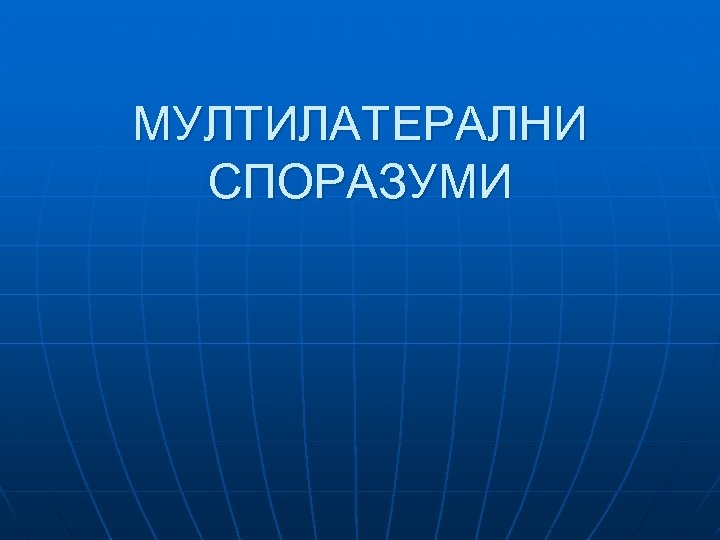
МУЛТИЛАТЕРАЛНИ СПОРАЗУМИ

THE NON-PROLIFERATION TREATY – 1968. n n n INTERNATIONAL ATOMIC ENERGY AGENCY (IAEA) 172 ПОТПИСНИЦЕ ИЗРАЕЛ, ПАКИСТАН, ИНДИЈА, ИЗВАН

COMPREHENSIVE TEST BAN TREATY – 1996. n n n ДА ЗАБРАНИ СВЕ НУКЛЕАРНЕ ПРОБЕ САД ПРОТИВ ИНДИЈА И ПАКИСТАН 1998.

3. ХЕМИЈСКО И БИОЛОШКО ОРУЖЈЕ

3. 1. ХЕМИЈСКО ОРУЖЈЕ n n УПОТРЕБОМ ХЕМИЈСКОГ ОРУЖЈА ОСЛОБАЂАЈУ СЕ ХЕМИКАЛИЈЕ КОЈЕ ОНЕСПОСОБЉАВАЈУ И УБИЈАЈУ ЉУДЕ ПОСТОЈИ ВИШЕ ВРСТА ХЕМИЈСКОГ ОРУЖЈА, ОД НЕРВНИХ ГАСОВА ДО НАЈОБИЧНИЈИХ СУЗАВАЦА

хемијска оружја се могу поделити у четири групе n n а) загушљивци и онеспособљивци као што су хлор и фосген; б) крви отрови као хидроген – цијанид и цијаноген – хлорид; в) пликавци као што су иперит и лусит и г) нервни отрови попут табуна, сарина, соман и V агенаса

КАКО ”УБИЈАЈУ“ ХЕМИЈСКА ОРУЖЈА n n n ОШТЕЋУЈУ НЕРВНИ СИСТЕМ, КРВОТОК, ДИСАЈНЕ ОРГАНЕ И ДРУГЕ ТЕЛЕСНЕ ФУНКЦИЈЕ ТЕШКО СЕ ШТИТИТИ ОД ЊИХ-ГАС МАСКЕ И РАЗНЕ ДРУГЕ ШТА СА ЦИВИЛИМА? ИЗРАЕЛ КАО ИЗУЗЕТАК

УПОТРЕБА ХЕМИЈСКИХ ОРУЖЈА n n ПРВИ СВЕТСКИ РАТ У ДРУГОМ СВЕТСКОМ РАТУ НИСУ КОРИШЋЕНА ИРАЧАНИ ПРОТИВ КУРДА НАЈЈЕФТИНИЈИ НАЧИН ДА ДРЖАВЕ И ДРУГИ АКТЕРИ У МЕЂУНАРОДНИМ ОДНОСИМА РАЗВИЈУ ОРУЖЈА ЗА МАСОВНО УНИШТАВАЊЕ

Halabja poison gas attack n n The Halabja poison gas attack was an incident on 15 March– 19 March 1988 during the Iran-Iraq War when chemical weapons were used by the Iraqi government forces to kill a number of people in the Iraqi Kurdish town of Halabja (population 80, 000). Estimates of casualties range from several hundred to 7, 000 people. Halabja is located about 150 miles northeast of Baghdad and 8 -10 miles from the Iranian border. Halabja was not the first time Iraq had turned its chemical arsenal on the Kurds. Thousands -- and most likely tens of thousands -- of civilians were killed during chemical and conventional bombardments stretching from the spring of 1987 through the fall of 1988. The attacks were part of a long-standing campaign that destroyed almost every Kurdish village in Iraq -- along with a centuries-old way of life -- and displaced at least a million of the country's estimated 3. 5 million Kurdish population
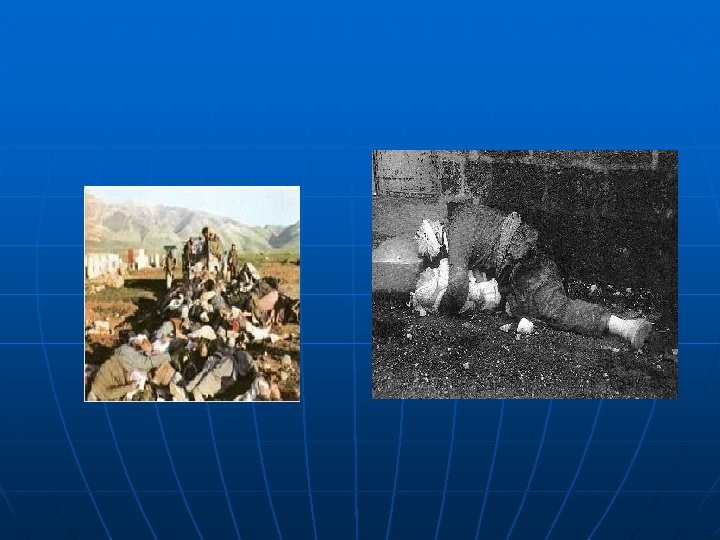

КОНТРОЛА ХЕМИЈСКОГ ОРУЖЈА n n n ЖЕНЕВСКИ ПРОТОКОЛ 1925 КОНВЕНЦИЈА О ХЕМИЈСКОМ ОРУЖЈУ ИЗ 1992. ГОДИНЕ-ЗАБРАНА ПРОИЗВОДЊЕ И КОРИШЋЕЊА ХЕМИЈСКОГ ОРУЖЈА; ПРЕТЊА САНКЦИЈАМА 175 ДРЖАВА ЈУ ЈЕ ПОТПИСАЛО ТАЈНИ ПРОГРАМИ РУСКИ ПРОБЛЕМ СА УНИШТАВАЊЕМ 44 000 ТОНА ХЕМИЈСКОГ ОРУЖЈА ИЗ ВРЕМЕНА ХЛАДНОГ РАТА

3. 2. БИЛОШКА ОРУЖЈА n n УПОТРЕБОМ БИОЛОШКОГ ОРУЖЈА ОСЛОБАЂАЈУ СЕ МИКРООРГАНИЗМИ И ИЗ ЊИХ ИЗВЕДЕНИ ОТРОВИ КОЈИ ОНЕСПОСОБЉАВАЈУ И УБИЈАЈУ ЉУДЕ ВИРУСИ, БАКТЕРИЈЕ БОГИЊЕ, АНТРАКС И СЛ. ВЕОМА ОПАСНА ПО САВ ЖИВИ СВЕТ

n n n ПРАКТИЧНО СУ ВЕОМА РЕТКО КОРИШЋЕНА У РАТУ ЈАПАН У НЕКИМ КИНЕСКИМ СЕЛИМА У ДРУГОМ СВЕТСКОМ РАТУ АНТРАКС И СОВЈЕТСКИ ПРОГРАМ РАЗВОЈА БИОЛОШКОГ ОРУЖЈА КАО ВЕОМА ОПАСНИ

постоји пет категорија билошких организама који се гаје да би се користили у ратне сврхе: n n n а) вируси б) бактерије в) гљивице г) рикеције г) токсини
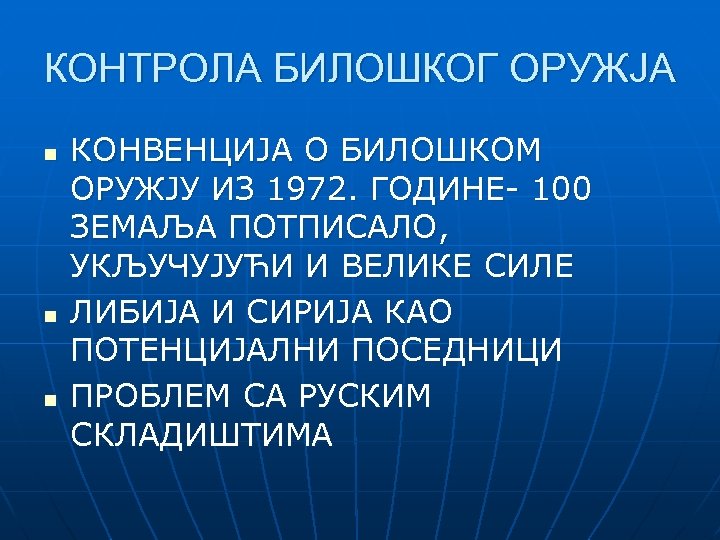
КОНТРОЛА БИЛОШКОГ ОРУЖЈА n n n КОНВЕНЦИЈА О БИЛОШКОМ ОРУЖЈУ ИЗ 1972. ГОДИНЕ- 100 ЗЕМАЉА ПОТПИСАЛО, УКЉУЧУЈУЋИ И ВЕЛИКЕ СИЛЕ ЛИБИЈА И СИРИЈА КАО ПОТЕНЦИЈАЛНИ ПОСЕДНИЦИ ПРОБЛЕМ СА РУСКИМ СКЛАДИШТИМА
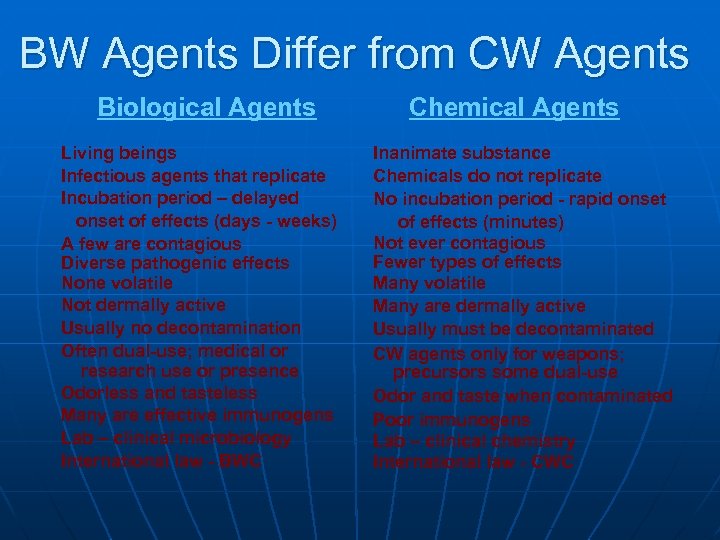
BW Agents Differ from CW Agents Biological Agents Living beings Infectious agents that replicate Incubation period – delayed onset of effects (days - weeks) A few are contagious Diverse pathogenic effects None volatile Not dermally active Usually no decontamination Often dual-use; medical or research use or presence Odorless and tasteless Many are effective immunogens Lab – clinical microbiology International law - BWC Chemical Agents Inanimate substance Chemicals do not replicate No incubation period - rapid onset of effects (minutes) Not ever contagious Fewer types of effects Many volatile Many are dermally active Usually must be decontaminated CW agents only for weapons; precursors some dual-use Odor and taste when contaminated Poor immunogens Lab – clinical chemistry International law - CWC
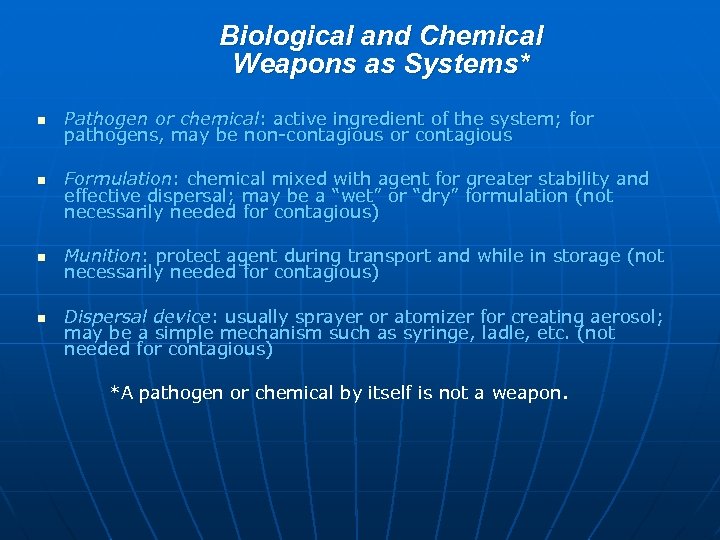
Biological and Chemical Weapons as Systems* n n Pathogen or chemical: active ingredient of the system; for pathogens, may be non-contagious or contagious Formulation: chemical mixed with agent for greater stability and effective dispersal; may be a “wet” or “dry” formulation (not necessarily needed for contagious) Munition: protect agent during transport and while in storage (not necessarily needed for contagious) Dispersal device: usually sprayer or atomizer for creating aerosol; may be a simple mechanism such as syringe, ladle, etc. (not needed for contagious) *A pathogen or chemical by itself is not a weapon.


U. S. M 143 Biological Bomb - Exterior U. S. M 143 Biological Bomb Exterior

U. S. M 143 Biological Bomb – Cross Section

Iraqi R 400 A Aerial Biological Bomb
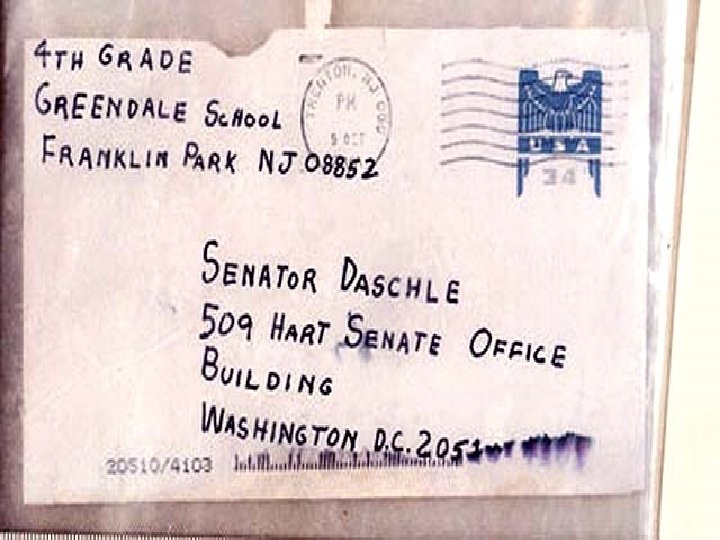
cc

Al Hussein Missile Fictionalized Artist’s Rendition Pre-1992

Encapsulation Equipment

Encapsulated Bacteria
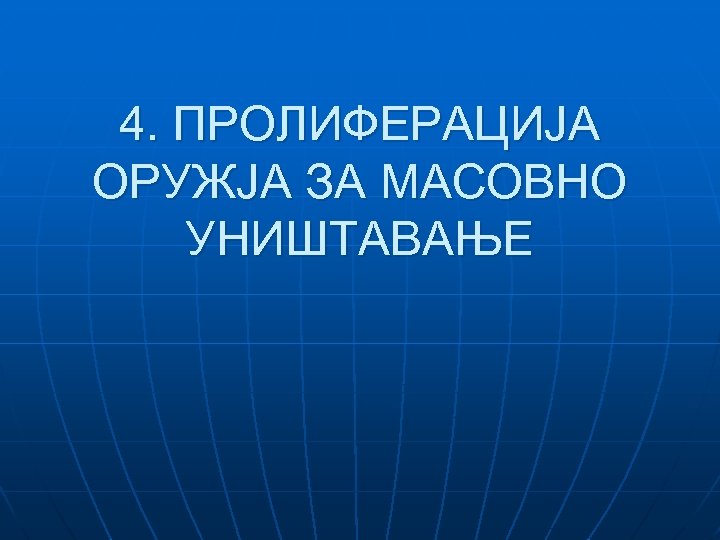
4. ПРОЛИФЕРАЦИЈА ОРУЖЈА ЗА МАСОВНО УНИШТАВАЊЕ

ПРОЛИФЕРАЦИЈА n n ПРОЛИФЕРАЦИЈА КАО ШИРЕЊЕ БРОЈА АКТЕРА КОЈИ ПОСЕДУЈУ НЕКА ОД ИЛИ СВА ОД ОРУЖЈА ЗА МАСОВНО УНИШТАВАЊЕ ДЕМОКРАТИЗАЦИЈА НАСИЉА ТРАНСНАЦИОНАЛНИ АКТЕРИ ПАРАДОКС МОЋИ И МОЋ СЛАБИХ


5. ЛИТЕРАТУРА n n n JOSHUA S. GOLDSTEIN, INTERNATIONAL RELATIONS, LONGMAN, NEW YORK, 2004, FIFTH EDITION JOHN T. ROURK, INTERNATIONAL POLITICS ON THE WORLD STAGE, DUSHKIN MCGRAW HILL, NEW YORK, 1999, SEVENTH EDITION ČARLS KEGLI JR. , JUDŽIN VITKOF, SVETSKA POLITIKA, CENTAR ZA STUDIJE JUGOSITOČNE EVROPE, DIPLOMATSKA AKADEMIJA, FAKULTET POLITIČKIH NAUKA, BEOGRAD, 2004 RADOVAN VUKADINOVIĆ, NUKLEARNE STRATEGIJE SUPERSILA, AUGUST CESAREC, ZAGREB, 1985 RADOMIR VUJKOVIĆ, SPORAZUMI O KONTROLI NAORUŽANJA, NIU VOJSKA, BEOGRAD, 1998
077c871bf3b75e65e687aa3c581eaea4.ppt